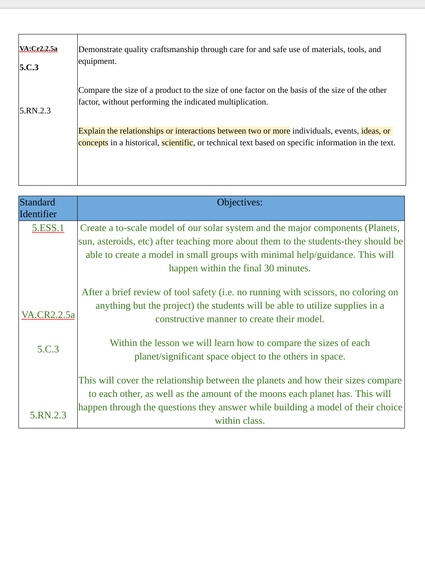
InTASC Standard 7
InTASC Standard #7 Planning for Instruction:
The teacher plans instruction that supports every student in meeting rigorous learning goals by drawing upon knowledge of content areas, curriculum, cross-disciplinary skills, and pedagogy, as well as knowledge of learners and the community context (InTASC, 2013).
Brief Discription of Evidence:
During the fall semester of 2021 as part of my EDUC 224- Introduction to Scientific Inquiry class, I had the opportunity to design my own in-depth lesson plan about the solar system with group members. The class was assigned groups and a certain grade level, and my group had the fifth grade. We created grade-level appropriate lesson plans to teach. I researched different activities and labs that would be beneficial to the topic of the lesson. After designing our lesson plans, we all presented them to the class as if they were that grade level.
Analysis of What I Learned:
Throughout designing and implementing the process of completing the solar system lesson plan, I have learned to make it as easy as possible to follow along. We made sure that everything was well prepared. We made sure to use all of our activities and kept the lesson fun to learn. I learned that it is harder to make a more in-depth lesson plan for students and follow everything that we have in the lesson. On top of everything you also have to be making checkpoints for students so that you know that they understand. It is hard to make sure that you are asking higher-quality questions to make sure the students are making small connections to the material so that I knew that the students were understanding the content.
How This Artifact Demonstrates my Competence on the InTASC Standard:
I have demonstrated my competence in this standard by completing and implementing an in-depth lesson plan for the class. We were able to come up with accurate learning goals by looking back on prior knowledge of the solar system. We were able to look back at the curriculum to come up with activities to challenge the learners’ minds to come up with more questions for them to ask. My colleagues and I made this lesson cross-disciplinary with science, art, and math. We used different teaching strategies such as content-focused methods and learner-based methods when teaching our lesson plan. Content-focused methods are more focused on the topics or subject matter and learner-based methods are more focused on activities that revolve around the students so that they are able to use their knowledge and use it. We looked at the previous grade-level standards to see what the students should know to help review and add on. We used some great simulations to help the students look more at what else is in space besides the planets. We were able to come up with some great accommodations to help manage some difficulties doing some of the activities. The students were able to learn about the world community context by learning about how the solar system is important to us. One theorist I know ties into this lesson is David Kolb because he developed the theory that children pass through four different stages to transform their experiences into knowledge. As stated by research, “Kolb’s experiential learning cycle is a four-stage process that describes a four-stage process of how we acquire and embed new knowledge” (St Emlyn’s, 2018). This is important to understand that it takes time and certain stages for children to go through to actually understand and connect to what they are being taught. This theory relates to the standard because students are able to draw on previous knowledge about the solar system to understand more in-depth components of what is in the solar system. David Kolb’s theory also relates to my standard because he states you go through four different stages starting with concrete experience, the students did a padlet to answer what they know about space and look at what their peers had put too. The next stage is the reflective observation of the new experiences, the students went through this in the lesson plan when they were able to reflect and talk about each of the videos and tell us something they learned that they didn’t know. The next stage is abstract conceptualization, the students did this in the lesson by reflecting on what they think about space junk and how we can help by preventing space junk. The final stage is active experimentation, the students did this by creating their component in space, answering why they chose that component and a list of important facts about what was said about that component and why it is important.
Resources
Council of Chief State School Officers. (2013, April). Interstate Teacher
Assessment and Support Consortium InTASC Model Core
Teaching Standards and Learning Progressions for Teachers 1.0: A Resource for Ongoing Teacher Development Washington, DC: Author.
St Emlyn’s. (2018, October 12). Educational theories you must know. Kolb’s learning cycle. St. Emlyn’s. St. Emlyn’s.
https://www.stemlynsblog.org/better-learning/educational-
theories-you-must-know-st-emlyns/educational-theories-you-
must-know-kolbs-learning-cycle-st-emlyns/










